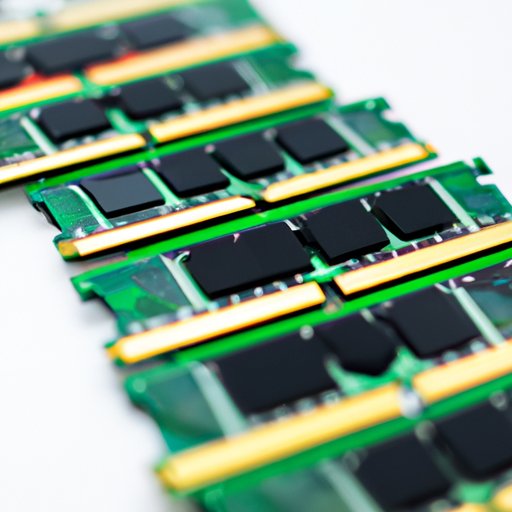Introduction
Random Access Memory (RAM) is an important part of any computer system. It is a type of computer data storage that holds information temporarily while the computer is running. RAM is used by programs to store data so it can be quickly accessed when needed. Knowing how much RAM you have is essential for ensuring your computer runs smoothly and efficiently.
Step-by-Step Guide on How to Check Your RAM
Checking your RAM is a relatively simple process and there are several ways you can do it depending on the operating system you are using. Here is a step-by-step guide on how to check your RAM on Windows, Mac, and Linux.
Checking RAM on Windows
The easiest way to check your RAM on Windows is to use the Task Manager. To open the Task Manager, press the Ctrl + Shift + Esc keys on your keyboard. Once the Task Manager opens, click on the Performance tab. On this tab, you will see the amount of RAM installed in your system as well as the amount of RAM being used.
Checking RAM on Mac
On Mac, you can easily check your RAM by opening the Activity Monitor application. To do this, open Finder, select Applications from the left sidebar, and then select Utilities. From there, you should be able to find the Activity Monitor application. When the application opens, you will see the total amount of RAM installed in your system as well as the amount of RAM being used.
Checking RAM on Linux
Linux users can easily check their RAM usage by opening the Terminal application. To do this, open the Dash and search for “Terminal”. Once the Terminal opens, type in the command “free -m” and press enter. This should display the total amount of RAM installed in your system as well as the amount of RAM being used.
Benefits of Knowing How Much RAM You Have
Knowing how much RAM you have can provide many benefits, such as improved performance and more efficient use of resources. With more RAM, your computer will be able to run more programs simultaneously without slowing down or crashing. Additionally, having more RAM allows your computer to access data faster, resulting in improved performance.

Differences Between RAM and Storage
It’s important to understand the differences between RAM and storage. RAM is a type of volatile memory that stores data temporarily while the computer is running. Storage, on the other hand, is a type of non-volatile memory that stores data permanently even after the computer is turned off. The main difference between RAM and storage is that RAM is much faster than storage, making it ideal for quick access to data.
Different Types of RAM
There are several different types of RAM available, each with its own advantages and disadvantages. The most common types of RAM are Dynamic Random Access Memory (DRAM), Static Random Access Memory (SRAM), Synchronous Dynamic Random Access Memory (SDRAM), Double Data Rate (DDR), and Graphics Double Data Rate (GDDR). Each type of RAM has its own specifications and features, so it’s important to research which type of RAM is best for your needs.

Steps for Checking RAM on Different Operating Systems
Depending on the operating system you are using, the steps for checking RAM may vary slightly. Here is a brief overview of the steps for checking RAM on Windows, Mac, and Linux.
Windows
- Open the Task Manager
- Click on the Performance tab
- Check the amount of RAM installed and being used
Mac
- Open the Activity Monitor application
- Check the amount of RAM installed and being used
Linux
- Open the Terminal application
- Type in the command “free -m” and press enter
- Check the amount of RAM installed and being used

Tips for Optimizing RAM Usage
Once you know how much RAM you have, there are several steps you can take to optimize RAM usage. First, make sure to close any unused programs or browser tabs. Additionally, you can increase the size of your virtual memory if your RAM is low. It is also important to keep your operating system up-to-date to ensure optimal performance. Finally, if all else fails, you may want to consider upgrading your RAM.
Conclusion
In conclusion, knowing how much RAM you have is important for ensuring your computer runs smoothly and efficiently. There are several ways to check your RAM depending on the operating system you are using. Additionally, understanding the differences between RAM and storage can help you make the most of your system’s resources. Finally, there are several steps you can take to optimize RAM usage and improve your computer’s performance.
Final Thoughts on RAM
Understanding RAM and how to check it can help you make the most of your system’s resources. While it may seem like a daunting task at first, checking your RAM is actually quite easy. With just a few clicks, you can get an accurate picture of how much RAM you have and take steps to optimize its usage. In the end, taking the time to check your RAM can make all the difference in the performance of your computer.


